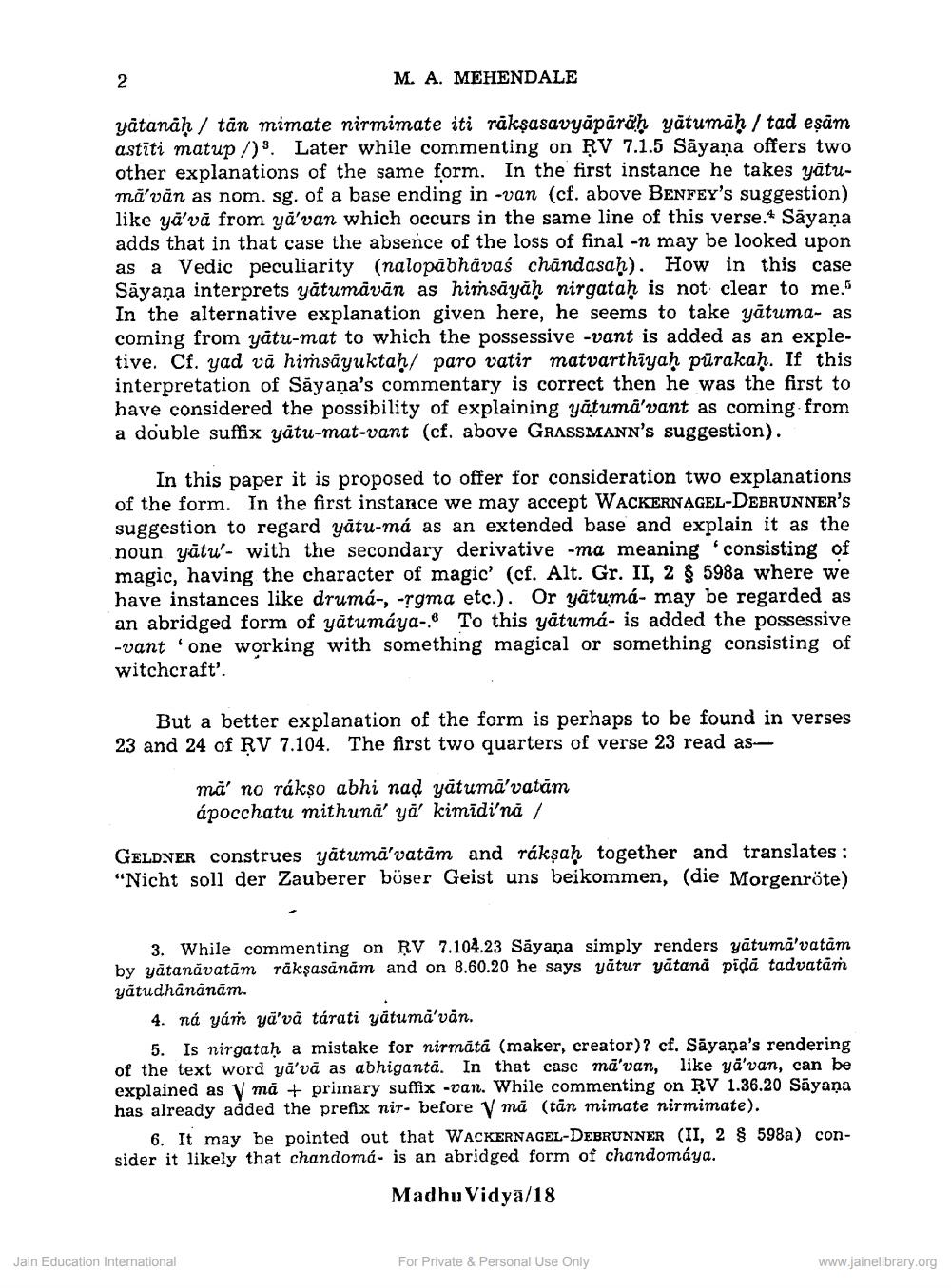________________
M. A. MEHENDALE
yàtanah / tän mimate nirmimate iti räkşasavyāpārāh yātumah / tad esam astiti matup /)s. Later while commenting on ķV 7.1.5 Sāyaṇa offers two other explanations of the same form. In the first instance he takes yātuma'van as nom. sg. of a base ending in -van (cf. above BENFEY's suggestion) like yā'vă from yā'van which occurs in the same line of this verse.* Sāyana adds that in that case the absence of the loss of final -n may be looked upon as a Vedic peculiarity (nalopābhāvaś chāndasah). How in this case Sāyaṇa interprets yatumāvān as hiṁsāyaḥ nirgatah is not clear to me.5 In the alternative explanation given here, he seems to take yātuma- as coming from yātu-mat to which the possessive -vant is added as an expletive. Cf. yad vă himsāyuktah/ paro vatir matvarthiyah pūrakaḥ. If this interpretation of Sāyaṇa's commentary is correct then he was the first to have considered the possibility of explaining yātuma'vant as coming from a double suffix yātu-mat-vant (cf. above GRASSMANN's suggestion).
In this paper it is proposed to offer for consideration two explanations of the form. In the first instance we may accept WACKERNAGEL-DEBRUNNER'S suggestion to regard yātu-má as an extended base and explain it as the noun yātu'- with the secondary derivative -ma meaning "consisting of magic, having the character of magic' (cf. Alt. Gr. II, 2 g 598a where we have instances like drumá-, -rgma etc.). Or yatumá- may be regarded as an abridged form of yātumáya-6 To this yātumá- is added the possessive -vant 'one working with something magical or something consisting of witchcraft'.
But a better explanation of the form is perhaps to be found in verses 23 and 24 of RV 7.104. The first two quarters of verse 23 read as
ma' no rákso abhi nad yātuma'vatām ápocchatu mithuna' ya' kimidi'na /
GELDNER construes yātuma'vatàm and rákṣaḥ together and translates : "Nicht soll der Zauberer böser Geist uns beikommen, (die Morgenröte)
3. While commenting on RV 7.104.23 Sayana simply renders yātuma'vatam by yatanăvatām raksasanam and on 8.60.20 he says yātur yatand pidä tadvatam yātudhananām.
4. Tả cảm gã”tárati gấtuma'sẵn.
5. Is nirgatan a mistake for nirmātā (maker, creator)? cf. Sāyana's rendering of the text word ya'vä as abhigantā. In that case ma'van, like yä'van, can be explained as V ma + primary suffix -van. While commenting on RV 1.36.20 Sāyana has already added the prefix nir- before y ma (tan mimate nirmimate).
6. It may be pointed out that WACKERNAGEL-DEBRUNNER (II, 28 598a) consider it likely that chandoma- is an abridged form of chandomáya.
Madhu Vidyā/18
Jain Education International
For Private & Personal Use Only
www.jainelibrary.org




